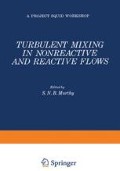Abstract
This discussion will be focussed on the plane turbulent mixing layer, featured in the illustration on the front of the program of this meeting. Another example of it is shown in Figure 1, while Figure 2 is a diagram which defines the basic parameters of this simplest of turbulent shear flows. Throughout this discussion the higher speed U1 will always be in the upper part of the diagram. The speed ratio U2/U1 will therefore always be less than unity, but the density ratio ρ2/ρ1 may be less than or greater than unity. In high-speed flow the Mach numbers M1 and M2 would also be parameters. In fact, our interest in this problem was initially addressed to the question of how the characteristics of the flow depend on the density ratio, it having been supposed by many investigators that this was the parameter governing the observed, strong variations of spreading angle in the shear layer at the edge of a supersonic flow (M1 > 1, M2 = 0).
Access this chapter
Tax calculation will be finalised at checkout
Purchases are for personal use only
Preview
Unable to display preview. Download preview PDF.
References
Bradshaw, P. 1966 The effects of initial conditions on the development of a free shear layer. J. Fluid Mech. 26, 225.
Brown, Garry & Roshko, Anatol 1971 The effect of density difference on the turbulent mixing layer. Turbulent Shear Flows, AGARD-CP-93, 23–1.
Brown, Garry & Roshko, Anatol 1971 On density effects and large structure in turbulent mixing layers. J. Fluid Mech. 64, 775–816.
Brown, G. L. & Rebollo, M. R. 1972 A small, fast-response probe to measure composition of a binary gas mixture. AIAA J. 10, 649.
Freymuth, Peter 1966 On transition in a separated laminar boundary layer. J. Fluid Mech. 25, 683.
Jones, B. G., Planchon, H. P. & Hammersley, R. J. 1973 Turbulent space-time correlation measurements in a plane two-stream mixing layer at velocity ratio 0.3. AIAA Paper No. 73-225.
Moore, D. W. & Saffman, P. G. 1974 The density of organized vortices in a turbulent mixing layer. To be published.
Papailiou, D. D. & Lykoudis, P. S. 1974 Turbulent vortex streets and the entrainment mechanism of the turbulent wake. J. Fluid Mech. 62, part 1, 11–31.
Rebollo, Manuel 1973 Analytical and experimental investigation of a turbulent mixing layer of different gases in a pressure gradient. Thesis for the Ph.D. degree, California Institute of Technology.
Spencer, B. W. & Jones, B. G. 1971 Statistical investigation of pressure and velocity fields in the turbulent two-stream mixing layer. AIAA Paper No. 71-613.
Sunyach, Michel 1971 Contribution a l’étude des frontiéres d’écoulements turbulents libres. Thesis for D. Sc. degree, L’Université Claude Bernard de Lyon.
Taneda, S. 1959 Downstream development of the wakes behind cylinders. J. of the Physical Society of Japan, 14, no. 6, 843–848.
Winant, C. D. & Browand, F. K. 1974 Vortex pairing: the mechanism of turbulent mixing layer growth at moderate Reynolds numbers. J. Fluid Mech. 63, 237.
Wygnanski, I. & Fiedler, H. E. 1970 The two-dimensional mixing region. J. Fluid Mech. 41, 327.
Author information
Authors and Affiliations
Editor information
Editors and Affiliations
Rights and permissions
Copyright information
© 1975 Plenum Press, New York
About this chapter
Cite this chapter
Roshko, A. (1975). Progress and Problems in Understanding Turbulent Shear Flows. In: Murthy, S.N.B. (eds) Turbulent Mixing in Nonreactive and Reactive Flows. Springer, Boston, MA. https://doi.org/10.1007/978-1-4615-8738-5_15
Download citation
DOI: https://doi.org/10.1007/978-1-4615-8738-5_15
Publisher Name: Springer, Boston, MA
Print ISBN: 978-1-4615-8740-8
Online ISBN: 978-1-4615-8738-5
eBook Packages: Springer Book Archive

